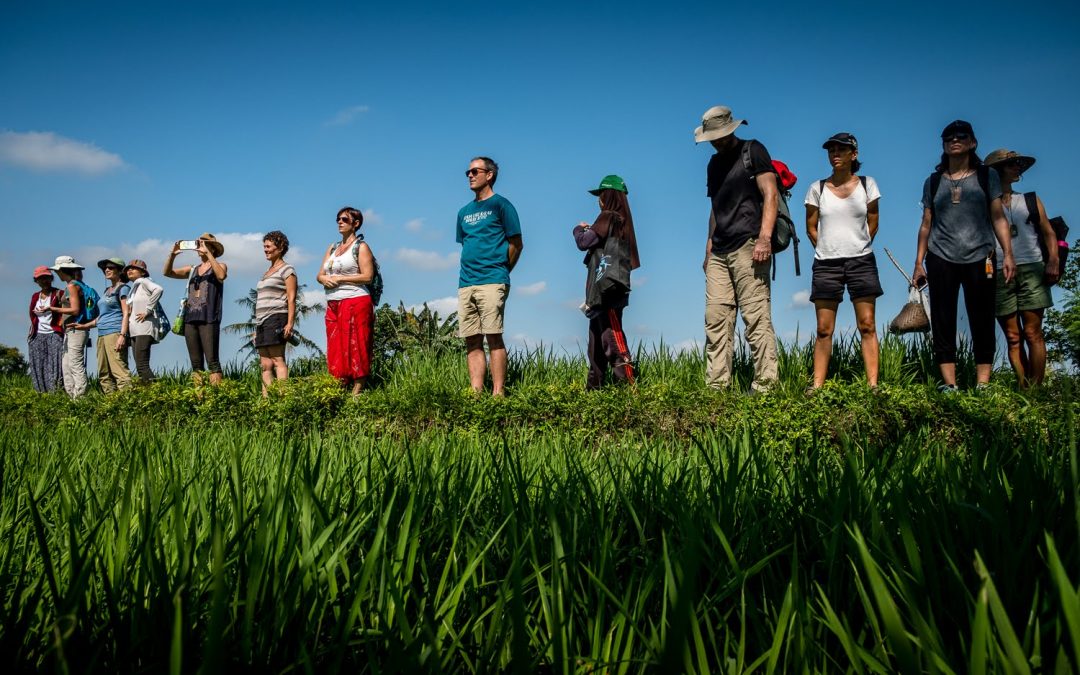A Parent’s Experience
It’s official. l’m a rice farmer (even though I’ve never had much of a garden let alone a green thumb). And it’s all thanks to a quiet revolution started by Kul Kul Connection (KKC), Green School’s Community Integration Program.
The call to arms came from KKC’s Tim Fijal, last September.
After an impassioned talk at the newly-opened Bridge (Green School’s co-working/co-learning space) about how Green School’s international community needs to connect more with local culture, he had a group of about 12 (mostly new) parents totally intrigued.
I knew little about KKC and assumed it was somehow linked to Kul Kul Farm. It isn’t.
KKC provides after-school English lessons for 400 kids from surrounding schools, not to mention a number of rich cultural experiences both kids and parents can get involved in.
Tim pitched his idea for us to build a kubu (a small shelter) for one of the elderly local rice farmers.

But when KKC’s liaison officer, Giyan Adnya Antari, sat down with farmers from Uma Lambing Subak (located about 25 minutes over the bamboo bridge from school), they expressed an interest in teaching us how to farm organic rice instead.
And so the KKC Semester 1 Rice Farming Course was born.
Every Thursday morning following a short trek through rice fields, we’d meet at the Subak’s bale, near its temple, with the mighty Mount Agung visible in the distance.
Shoes off, we’d plunge our feet into the cool, squishy mud.

Under the gentle guidance of five farmers we learned how to germinate the seeds for our rice using a red heritage variety sourced from the magnificent Jatiluwih rice terraces.
We turned the soil and tilled the field (using cows, who FYI don’t work Thursdays, so a few schedule changes had to be made).
And we planted our rice babies, in somewhat meandering rows, across the 5 are/500 sqm plot, using natural fertilisers (cow poo).

Fish were released into the muddy waters (excellent pest control) and there was always plenty of weeding to keep our paddy tidy.
After each session in the hot hot sun, we’d gather to chat under the bale, building a dialogue and relationships with the farmers.
We drank fresh coconut water together, the sweet juice dribbling down our chins, and munched on delicious jaje (snacks) prepared by farmer Pak Wayan Suwendi’s wife.
Some of us had experience in permaculture. Others (like me, used to apartment living) didn’t.
The magic, we all realised, was not so much that we were learning how to farm rice – but that we were doing it with the Balinese, on the land their ancestors had farmed for generations.
“I felt like I was stepping out of the bamboo bubble of Green School and making a real connection with Balinese life,” says Mariet van Linschoten, who was inspired to help elderly farmers after seeing the photo exhibit The Rice Warrior of Bali at the beginning of the school year.

Another course participant, Melanie Clifford, relished the journey into the unknown.
“It was a real organic experience, pottering around the land, watching it all unfold. I felt very privileged to be there and to be allowed to learn from the farmers.”
And it was all captured by stunning photographer and course participant, Adrian Chitty.
As the rice grew, so did our understanding of the challenges the farmers face: the degradation of their soil (after decades of Government policy that resulted in farmers using hybrid seeds and chemical fertilisers); their struggle securing a decent income; and the lack of interest from the next generation to step up and take over.

The farmers, always so humble, were blown away by the interest.
“Having parents come to our land who are concerned about the health of the environment and also the farmers motivates us to continue preserving out tradition,” says Subak chief, Pak Made ‘Deny’ Widana, translated through KKC’s Giyan.
“It makes us proud to be farmers.”

Pak Deny hopes more farmers from the Subak see the benefits and return to traditional (chemical-free) farming techniques.
Our two handmade scarecrows (Ivana and Trump) successfully kept the birds at bay, because come harvest day, our rice babies were as tall as I am. Ok, so I’m not that tall.

With family and friends in toe, we cut each individual stork by hand, delivering our golden produce to the Paks to dry out in the sun, and eventually mill at the koperasi nearby.
Since then we’ve been involved in launching the rice with the farmers, liaising on everything from a website, to a logo and a brand name: Uma Lambing Beras Sehat (Healthy Rice).
And finally, with 1kg bags distributed to course participants, I served a meal of our Beras Sehat to my family, which was pretty special. An authentic ‘seed to plate’ journey I can’t imagine replicating anywhere else.
Meanwhile, this green revolution is growing. Semester 2 Rice Farming Course is up and running with 26 participants and 4 times the amount of land!

There’s talk Green School might become a regular customer and students are heading out to spend time in the fields, which for Tim (KKC), is a dream come true.
“I always had an intuition that being out in the rice paddies, interacting with the Balinese rice farmers can instill Green School values in our hearts,” he says.
“It’s learning by doing, with Bali as the teacher, in a truly wall-less environment.”
As for that original idea to build farmers a kubu? It’s branched off into another KKC driven project. So watch out for that too.
Written by Sandra Radice, Green School Bali Parent.
Want to farm your own Beras Sehat or to get involved in KKC’s many cultural programs visit: www.kulkulconnection.www.greenschool.org or www.subakumalambing.com

